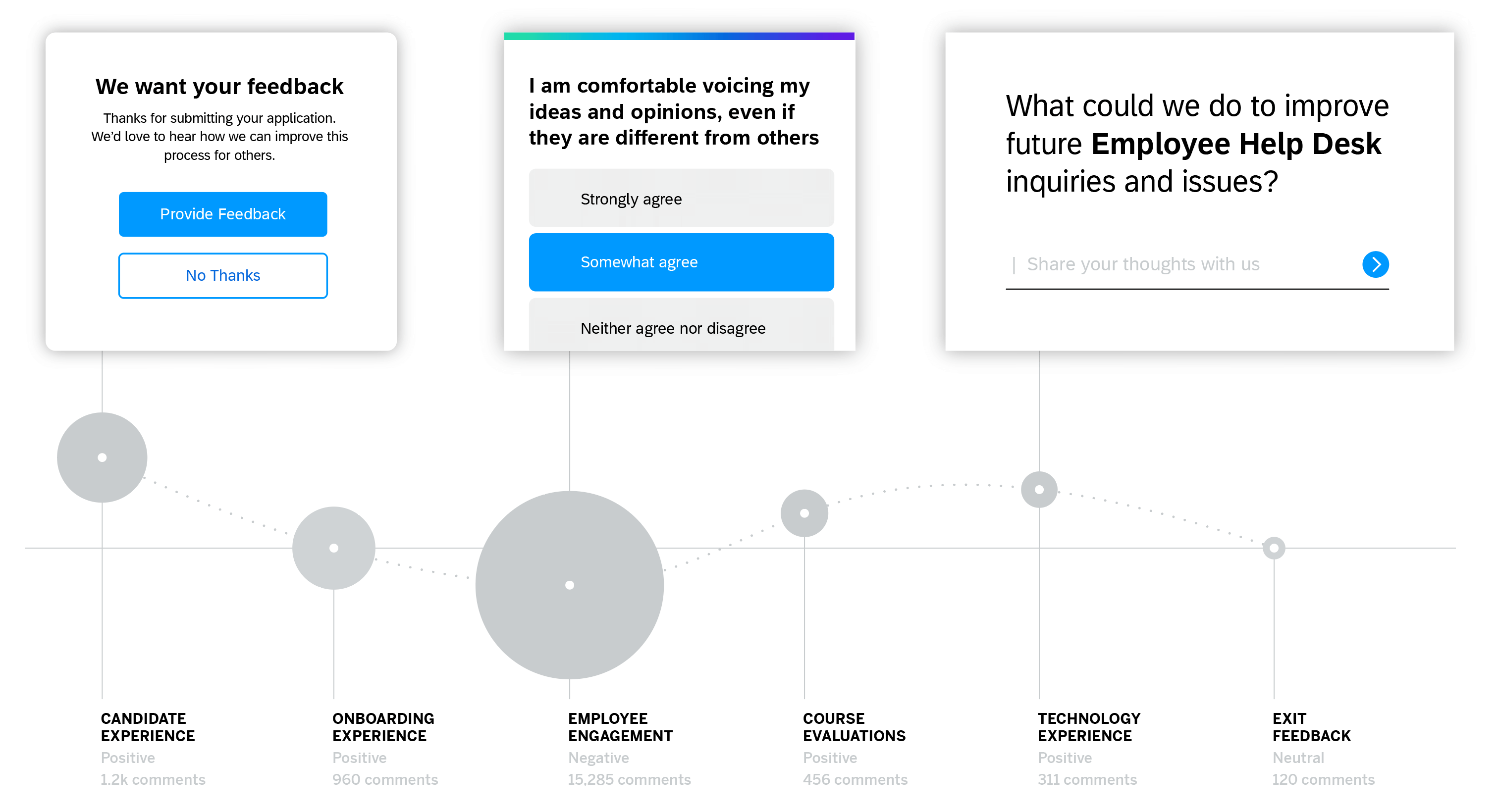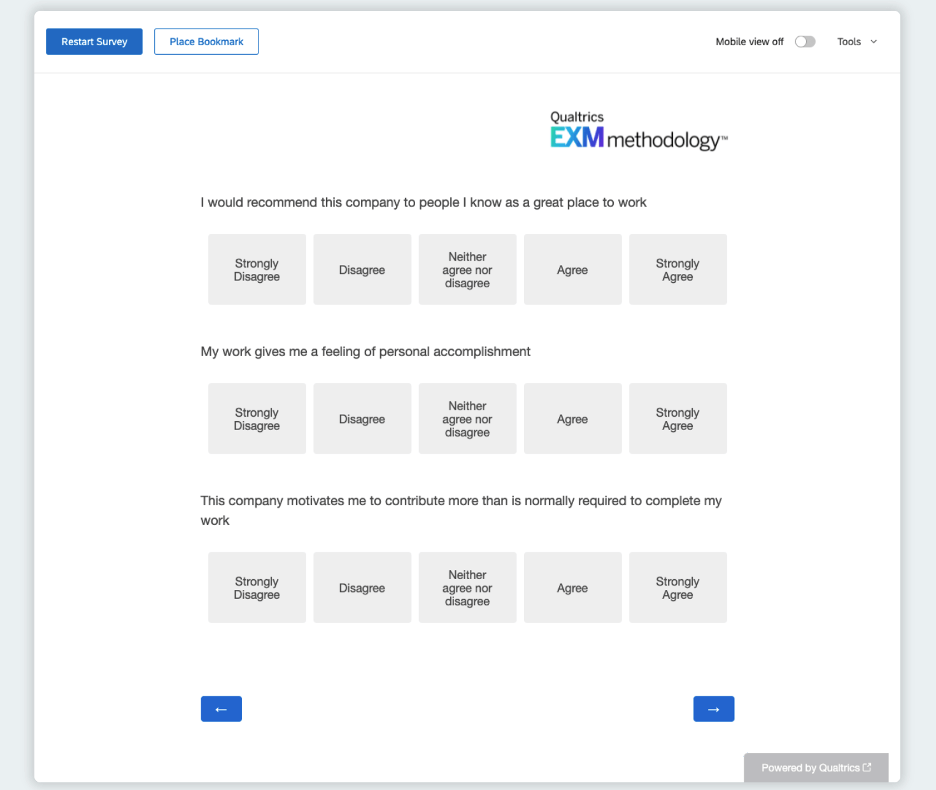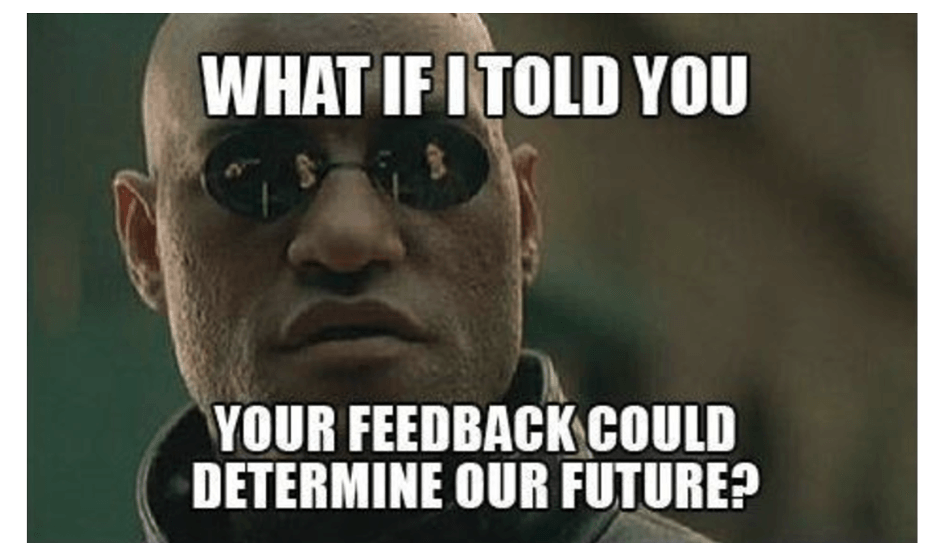What is an employee survey?
An employee survey is a method of information gathering or research that uses questions to uncover specific opinions or feedback (although it can also provide other kinds of data). The information is then analysed to help identify trends or key insights.
Employee surveys are often used to assess levels of engagement or employee satisfaction, but there are several other ways to use them. For example, you can use them to highlight areas of opportunity or improvement or build better organisational relationships and cultures.
Ebook: Your Essential Guide to Employee Experience Surveys

What are the different types of employee surveys?
There are a wide variety of employee surveys you can run. Here are some of the most common.
Employee engagement surveys
These employee surveys delve into employee engagement drivers to find out how motivated, committed, and emotionally invested your people are at work. These are often the most-used surveys in organisations.
Employee engagement surveys give you an idea of what’s building engagement up – or holding it back. Manager relationships, the workplace environment, work-life balance, and organisational culture, all play a role in shaping engagement. Your employee engagement survey will help you assess all of these factors.

Employee satisfaction surveys
Employee satisfaction is an essential building block of engagement and EX. An employee satisfaction survey helps you understand how content your people are with the basic arrangements of their working life, and if there are any roadblocks in the employee experience that are preventing them from achieving their true potential.
Pulse surveys
Employee pulse surveys take a little-and-often approach to gather employee experience data. Run every six months, or quarterly rather than every year, they’re more focused than traditional annual surveys. Also, regular pulse surveys have the benefit of more up-to-date experience data, and they’re quicker and easier for employees to complete.
Onboarding surveys
The employee onboarding phase is among the ‘moments that matter’ in the employee journey – meaning that it has a significant influence on the overall employee experience. An onboarding survey covers the all-important first stages of the employee’s career with your company and helps you understand the quality of your recruitment, application and interview process, as well as the employee’s first days and weeks on the job.
Exit interview surveys
Like onboarding, the final phase of an employee’s journey is highly influential on their experience as a whole. With exit interview surveys, you can gather insights about what makes employees want to leave and what might persuade them to stay. You’ll also be able to hear their views on the company and role from a unique perspective as they look back on their journey.
Who should use employee surveys?
Everyone with employees! Whether you’re a small start-up or a thriving enterprise company, or in the tech industry, education sector or travel management business, employee surveys have something to offer everyone.
Even the smallest of companies can benefit from standardised surveys, especially if they’re anonymous surveys as this gives employees the chance to have their honest feedback heard.
What’s the business case for employee surveys?
So, can employee surveys make you more profitable? What about the business impact, and how do survey results affect your company’s performance? Well…
Employee surveys exist to help you measure, track and improve the quality of the employee experience you’re offering. There are several direct and measurable benefits of a good employee experience, each with statistics and studies to back them up.
For example, our 2020 research showed that financially, EX leaders were 3x more likely to say they had significantly outperformed their competitors compared with EX laggards.
- A better customer experience
When employees are engaged and fulfilled at work, the customer experience gets better. And when customers have a great experience, they respond with increased loyalty and more confidence in the brand, connecting EX directly with a business’ bottom line. Aberdeen Group found that companies with an engagement program have 223% more customer loyalty than those without.
- Better employee retention
Unwanted turnover costs time, money and resources, and it can be destabilising to your company culture, especially when it disrupts close-knit teams. Research from Jacob Morgan indicates that companies with the highest standards of EX have 40% less turnover than their competitors.
- More power to attract top talent
Organisations where employees are engaged, satisfied and enjoying a good quality of life are likely to have an easier time recruiting the best new hires. As well as personal referrals and glowing reviews from existing employees, these EX leaders can use their strong employer brand to attract the best people for their job vacancies. LinkedIn found that 72% of recruitment leaders agreed that an employer’s brand has a significant impact on hiring.
How to create an employee survey
Collecting employee feedback with a survey means thinking about what questions you’ll ask, how you’ll distribute the survey and analyse the results, and what actions you’ll take based on the information you receive. Fortunately, there are processes, tools, and technologies available to make all these steps easier. Follow these steps:
1. Decide on your research goals
What do you want your employee survey to do for you? Is there a particular issue that prompted you to run a survey, or are you looking for a general picture of the employee experience in your company? Maybe you’ve run surveys in the past and want to get the practice up and running again.
Whatever the reason, consider writing a short ‘mission statement’ for your survey that sets out what you want to find out. Think about how you will use the information and what format your employee feedback should be in, as this will help you design your survey project.
2. Pick a survey platform
Employee surveys are typically run online, although you may want to have the option to collect survey data in person or over the phone too. Look for a platform that allows you plenty of flexibility so you can change your survey when you choose to, or adapt it to broaden the scope of your research. A cloud-based platform is the gold standard for many kinds of business software, and survey research is no exception.
As well as creating and distributing your survey, look for survey tools that offer data analysis capabilities too. Being able to run your survey results through a range of powerful analytics helps you get the most return from your time and effort.
3. Write your survey questions
Getting your survey questions right involves two important jobs – nailing the question wording and choosing the right question types.
Your question types depend partly on the kind of data you want to collect – for example, multiple choice question formats give you categorical data, whereas ranking questions give you information that’s hierarchical. The structure and length of the survey also play a role. If the survey is long, participants will be more likely to stick with it if you vary question types and achieve a good balance between high and low-effort questions.
Choosing the right wording for your survey questions helps make sure the respondent understands what you’re asking. Being clear and precise and avoiding any assumptions is important, as is keeping each question focused on a single topic.
4. Package and present your survey
To make your employee survey a success, ensure employees understand its purpose and value, and that they trust its provenance. Help save your survey from their spam folders by branding it with your logo and colours, if your survey provider offers this capability.
Make sure the ‘from’ address (if you’re sending your survey by email) is a familiar one and the subject line is informative and recognisably part of your internal communications.
Write an introductory statement for your survey that helps employees understand its goals. Assure them that the survey is an important use of their time and that their feedback is useful to the company as a whole. You can do this in a style and tone that reflects your company culture.
5. Follow up and remind participants
Not every employee will be able to respond to your survey straight away. Maximise the number of responses you get by sending out reminders to your participants to jog their memories. Reiterate the value of the research and the importance of their feedback when you do this.

What to do with your employee survey results
Your employee engagement survey – or onboarding survey or whichever survey type you are running – is complete and the results are in. What should you do next?
- Analyse the results
From cross-tab analysis and t-tests to sentiment analysis and predictive analytics, there are all kinds of analyses you can run on your employee survey data to gather insights and validate your results.
- Distribute your findings
Convert your data into a user-friendly format you can share with leaders and decision-makers in your organisation. A good survey platform will offer tools to generate reports, graphics and dashboards automatically.
- Take action
Use the momentum of your employee survey to make changes happen. If your results show areas for improvement or opportunities for new initiatives, make planning and executing them part of your project’s remit.
- Feed back to your employees
Make the link between the data your employees have provided and the action you’re taking. Let them know how you took the employee’s perspective to heart and used it to make your company better.
Try out Qualtrics EmployeeXM™
If you want to take an experience-first approach to your employee experience strategies, look no further than EmployeeXM.
Qualtrics EmployeeXM gathers continuous feedback from every employee experience, enabling you to take the right actions to improve engagement, streamline talent planning, increase productivity and drive innovation across every area of the business. It’s time to put your people first.
With Qualtrics EmployeeXM, hear every voice with an always-on listening engine, respond to more frequent feedback and act quickly to ensure meaningful change.
Start Creating Employee Experience Surveys Today